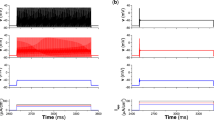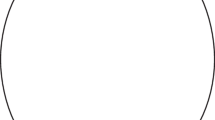Abstract
The effects of doublet impulse sequences of the excitatory axon on the output response as firing probability (pr.) in the computer-simulated nerve cell were examined. A simple model was formulated to simulate the nerve cell, including the property that the resetting potential is influenced by the final membrane potential in the previous stage before firing. The relationship between input sequences with alternating long and short interval at the same mean rate and the transient and steady responses of the nerve cell was investigated. In this simulation, three summarized results were obtained: i) The responses were very sensitive to changing small size of excitatory post-synaptic potential (EPSP), especially in the firing stage of the transient state. ii) In the transient state, the size of characteristic area of responses was depending upon the size of absolute refractory period (ARP). The rise for shorter intervals was faster than that for longer intervals, agreeing well with part of the experimental results from the crayfish claw opener muscles. The transient responses were almost finished before the fifth firing. iii) In the steady state, the doublet impulse sequences usually produced the minimum response or valley-like response at which the doublet interval T dwas 20 and/or 25 ms. These effects related to the characteristic areas in the transient responses.
Similar content being viewed by others
References
Gillary, H.L., Kennedy, D.: Pattern generation in a crustacean neuron. J. Neurophysiol. 32, 595–606 (1969a)
Gillary, H.L., Kennedy, D.: Neuromuscular effects of impulse pattern in a crustacean motoneuron. J. Neurophysiol. 32, 607–612 (1969b)
Hermann, H.T., Olsen, R.E.: Dynamic statistics of crayfish caudal photoreceptors. Biophys. J. 7, 279–296 (1967)
Perkel, D.H., Schulman, J.H., Bullock, T.H., Moore, G.P., Segundo, J.P.: Pacemaker neurons. Effects of regularly spaced synaptic input. Science 145, 61–63 (1964)
Ripley, S.H., Wiersma, C.A.G.: The effect of spaced stimulation of excitatory and inhibitory axons of the crayfish. Physiol. Comp. 3, 1–17 (1953)
Segundo, J.P., Moore, G.P., Stensaas, L.J., Bullock, T.H.: Sensitivity of neurons in Aplysia to temporal patterns of arriving impulses. J. Exp. Biol. 40, 643–667 (1963)
Segundo, J.P., Perkel, D.H., Moore, G.P.: Spike probability in neurons. Influence of temporal structure in the train of synaptic events. Kybernetik 3, 67–82 (1966)
Segundo, J.P., Perkel, D.H., Wyman, H., Hegstad, H., Moore, G.P.: Input-output relations in computer simulated nerve cells. Kybernetik 4, 157–177 (1968)
Sugano, N.: Effect of doublet impulse sequences in the crayfish claw opener muscles and the computer-simulated neuromuscular synapse. Biol. Cybern. 49, 55–61 (1983)
Sugano, N., Tsukada, M.: Effect of correlated adjacent interspike interval sequences of the excitatory motor axon on the opening movement of the crayfish claw opener muscles. Biol. Cybern. 29, 63–67 (1978)
Tsukada, M., Sugano, N.: Effect of correlated adjacent interspike interval sequences of the input on the output response in the computer-simulated neuromuscular system. Biol. Cybern. 29, 69–73 (1978)
Wakabayashi, T., Kuroda, T.: Responses of crayfish muscle preparations to nerve stimulation with various patterns of impulse sequence. Effects of intermittent intercalated and adaptational types of impulse sequence. Tohoku J. Exp. Med. 121, 207–218 (1977)
Wiersma, C.A.G., Adams, R.T.: The influence of nerve impulse sequence on the contractions of different crustaceans muscles. Physiol. Comp. 2, 20–33 (1950)
Wilson, D.M., Davis, W.J.: Nerve impulse patterns and reflex control in the motor system of the crayfish claw. J. Exp. Biol. 43, 193–210 (1965)
Author information
Authors and Affiliations
Rights and permissions
About this article
Cite this article
Sugano, N. Effect doublet impulse sequences on the transient and steady responses in the computer-simulated nerve cell. Biol. Cybern. 51, 123–128 (1984). https://doi.org/10.1007/BF00357925
Received:
Issue Date:
DOI: https://doi.org/10.1007/BF00357925




